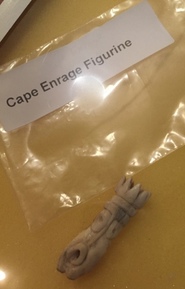 Photo courtesy Deb Carr
Photo courtesy Deb Carr Dr. David Black, who just recently retired from the Department of Anthropology at the University of New Brunswick, gave the talk to a room full of guests and answered questions later.
The figurine was found in 1998 on public land, on the cliff face of Cape Enrage, overlooking Waterside Beach by Daniel Kane who was looking for fossils. It was found on a rocky ledge, just above the water line and it is a small figurine. It is only 4.75 cm tall (just under 2 inches) and when Daniel found it, he thought at first it was a chess piece. It looked polished and was off-white in colour. From the back, what you see is just a column that doesn’t have much carved on it although you can see that there are points on the top, resembling a crown. However, when you look at the front of the figurine, there is much more carving. You can see the crown, but also two eyes, a nose and a mouth that looks partially open. Definitely not a chess piece.
Dr. Black then described the process that he and his colleagues used to try to uncover what this figurine was all about. Trying to classify artifacts is a lengthy and complicated process. Dr. Black outlined the process that they went through as they examined this piece. A lot of research, comparison and scientific testing went on for years.
They discovered that the piece was carved out of the left jaw of a white-tailed deer, a wild animal that had existed in the area. The nature of the cut marks used for the carving led the researchers to believe that a metal tool had been used, one that was either iron or steel. They ruled out the possibility that it was carved using a flaked stone tool. This helps to identify the age of the figurine.
There are no other pieces like it which also makes it very difficult to be able to say exactly what this figurine is. Without having a comparison, researchers can only make guesses about what it is. But these guesses come from their years of experience and their research.
Dr. Black feels that the figurine was carved by someone who was aboriginal, anywhere between 300 or 600 years ago. He showed pictures comparing the figurine’s headdress, the nose and the eyes to various other images and artifacts that are aboriginal in nature He classifies it as an “art” object, rather than it being a smoking pipe or a musical instrument. He also feels that it might have been used for religious purposes or in healing. He went on to say that it might have been a “sucking tube” used by shamans (medicine men) for healing people.
It was a very enjoyable evening of learning. Are there other objects out there? We don’t know. We all left wondering what else might be out there, waiting to be discovered.
Written by Susan Quinn, who has an interest in all things historical.
 RSS Feed
RSS Feed